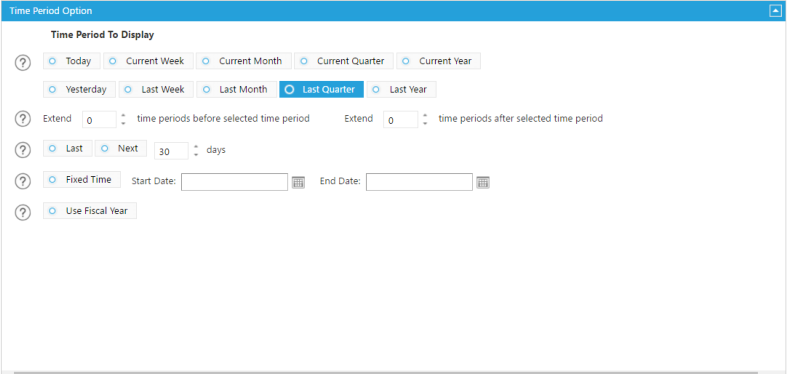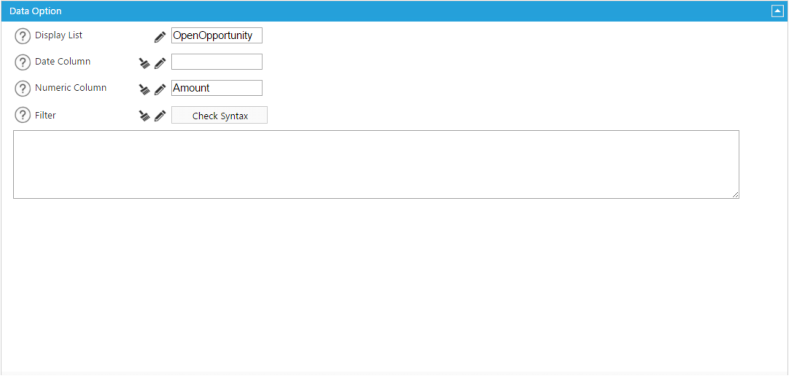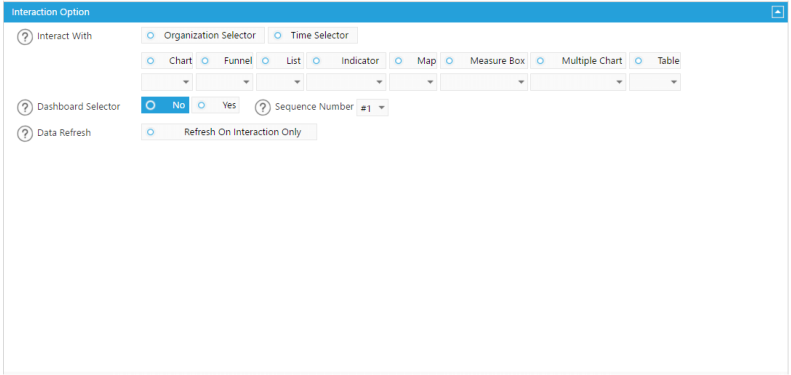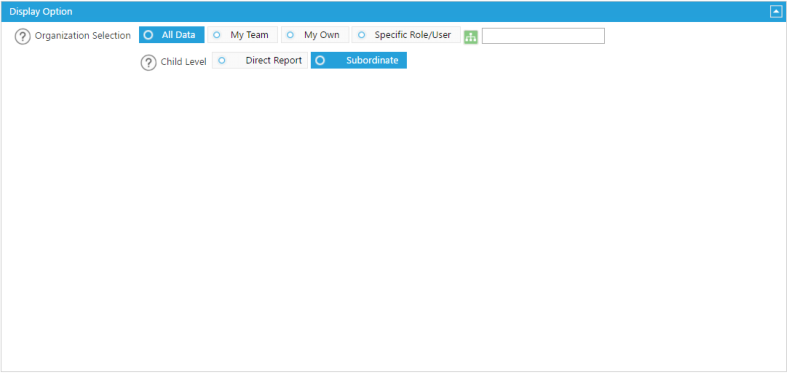List Summary
 Time Period Option
Time Period Option



 1.
Displays your data in the dashboard by the selected date
2.
Extends the time period selected above, before or after by a specified number of time periods. Make sure to uncheck the
Compared To selection below in order to do so.
3.
Select Daily Level if the trending data will show as daily. Choose Selected Period Level if the trending should match to the selected
time period level. For example, when Current Month is selected as time period the trending will be at monthly level.
4.
Displays your data in the dashboard by a specific number of past or future days.
5.
Displays your data using the Fiscal year as your selected time period.
1
2
3
4
5
1.
Displays your data in the dashboard by the selected date
2.
Extends the time period selected above, before or after by a specified number of time periods. Make sure to uncheck the
Compared To selection below in order to do so.
3.
Select Daily Level if the trending data will show as daily. Choose Selected Period Level if the trending should match to the selected
time period level. For example, when Current Month is selected as time period the trending will be at monthly level.
4.
Displays your data in the dashboard by a specific number of past or future days.
5.
Displays your data using the Fiscal year as your selected time period.
1
2
3
4
5




 Data Option
1
2
3
4
Data Option
1
2
3
4



 1.
The list will be displayed in the component.
2.
The date field associated with the selected list. This is used for conditioning purpose.
3.
Choose a Numerical field associated with the object to display.
4.
Custom filter option to further filter the measures selected above. Use the Check Syntax box before clicking OK to ensure the filter
will be applied effectively.
Interaction Option
1
1.
The list will be displayed in the component.
2.
The date field associated with the selected list. This is used for conditioning purpose.
3.
Choose a Numerical field associated with the object to display.
4.
Custom filter option to further filter the measures selected above. Use the Check Syntax box before clicking OK to ensure the filter
will be applied effectively.
Interaction Option
1
 2
2
 3
3
 4
4
 1.
Preset the other components with which you want this component’s data to react to when they are selected. Under each
component option you can choose ALL or a Sequence number (#1) which can be assigned to each component so that this data
only reacts when a certain numbered component is selected.
2.
Select Yes to make this component a dashboard selector so that other preset components will refresh when it is selected. Select
No if you do not want any other data to react to this selection.
3.
You can assign different sequence numbers to multiple of the same type of component to differentiate them.
4.
If you want the component to wait to load any data until you have made a selection from another component, select the Refresh
On Interaction Only box.
Display Option
1
1.
Preset the other components with which you want this component’s data to react to when they are selected. Under each
component option you can choose ALL or a Sequence number (#1) which can be assigned to each component so that this data
only reacts when a certain numbered component is selected.
2.
Select Yes to make this component a dashboard selector so that other preset components will refresh when it is selected. Select
No if you do not want any other data to react to this selection.
3.
You can assign different sequence numbers to multiple of the same type of component to differentiate them.
4.
If you want the component to wait to load any data until you have made a selection from another component, select the Refresh
On Interaction Only box.
Display Option
1
 2
2
 1.
Select a data level within your organization to limit data access for this component. Or select the green button to select a
specific role within your organization.
2.
Displays and sums up all of the users directly below the above selected level or role by the Direct Report. Or you can display and
sum up all of the users in all the levels below the selected data level by choosing the Subordinate box.
1.
Select a data level within your organization to limit data access for this component. Or select the green button to select a
specific role within your organization.
2.
Displays and sums up all of the users directly below the above selected level or role by the Direct Report. Or you can display and
sum up all of the users in all the levels below the selected data level by choosing the Subordinate box.
 Time Period Option
Time Period Option



 1.
Displays your data in the dashboard by the selected date
2.
Extends the time period selected above, before or after by a specified number of time periods. Make sure to uncheck the
Compared To selection below in order to do so.
3.
Select Daily Level if the trending data will show as daily. Choose Selected Period Level if the trending should match to the selected
time period level. For example, when Current Month is selected as time period the trending will be at monthly level.
4.
Displays your data in the dashboard by a specific number of past or future days.
5.
Displays your data using the Fiscal year as your selected time period.
1
2
3
4
5
1.
Displays your data in the dashboard by the selected date
2.
Extends the time period selected above, before or after by a specified number of time periods. Make sure to uncheck the
Compared To selection below in order to do so.
3.
Select Daily Level if the trending data will show as daily. Choose Selected Period Level if the trending should match to the selected
time period level. For example, when Current Month is selected as time period the trending will be at monthly level.
4.
Displays your data in the dashboard by a specific number of past or future days.
5.
Displays your data using the Fiscal year as your selected time period.
1
2
3
4
5




 Data Option
1
2
3
4
Data Option
1
2
3
4



 1.
The list will be displayed in the component.
2.
The date field associated with the selected list. This is used for conditioning purpose.
3.
Choose a Numerical field associated with the object to display.
4.
Custom filter option to further filter the measures selected above. Use the Check Syntax box before clicking OK to ensure the filter
will be applied effectively.
Interaction Option
1
1.
The list will be displayed in the component.
2.
The date field associated with the selected list. This is used for conditioning purpose.
3.
Choose a Numerical field associated with the object to display.
4.
Custom filter option to further filter the measures selected above. Use the Check Syntax box before clicking OK to ensure the filter
will be applied effectively.
Interaction Option
1
 2
2
 3
3
 4
4
 1.
Preset the other components with which you want this component’s data to react to when they are selected. Under each
component option you can choose ALL or a Sequence number (#1) which can be assigned to each component so that this data
only reacts when a certain numbered component is selected.
2.
Select Yes to make this component a dashboard selector so that other preset components will refresh when it is selected. Select
No if you do not want any other data to react to this selection.
3.
You can assign different sequence numbers to multiple of the same type of component to differentiate them.
4.
If you want the component to wait to load any data until you have made a selection from another component, select the Refresh
On Interaction Only box.
Display Option
1
1.
Preset the other components with which you want this component’s data to react to when they are selected. Under each
component option you can choose ALL or a Sequence number (#1) which can be assigned to each component so that this data
only reacts when a certain numbered component is selected.
2.
Select Yes to make this component a dashboard selector so that other preset components will refresh when it is selected. Select
No if you do not want any other data to react to this selection.
3.
You can assign different sequence numbers to multiple of the same type of component to differentiate them.
4.
If you want the component to wait to load any data until you have made a selection from another component, select the Refresh
On Interaction Only box.
Display Option
1
 2
2
 1.
Select a data level within your organization to limit data access for this component. Or select the green button to select a
specific role within your organization.
2.
Displays and sums up all of the users directly below the above selected level or role by the Direct Report. Or you can display and
sum up all of the users in all the levels below the selected data level by choosing the Subordinate box.
1.
Select a data level within your organization to limit data access for this component. Or select the green button to select a
specific role within your organization.
2.
Displays and sums up all of the users directly below the above selected level or role by the Direct Report. Or you can display and
sum up all of the users in all the levels below the selected data level by choosing the Subordinate box.
